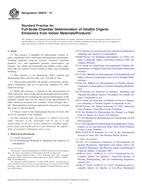Potrebujeme váš súhlas na využitie jednotlivých dát, aby sa vám okrem iného mohli ukazovať informácie týkajúce sa vašich záujmov. Súhlas udelíte kliknutím na tlačidlo „OK“.
ASTM D6271-10
Standard Test Method for Estimating Contribution of Environmental Tobacco Smoke to Respirable Suspended Particles Based on Solanesol
Automaticky preložený názov:
Štandardná skúšobná metóda pre odhad Príspevok Tabakový dym v prostredí s dýchateľným suspendovaných častíc na základe Solanesol
NORMA vydaná dňa 1.4.2010
Informácie o norme:
Označenie normy: ASTM D6271-10
Poznámka: NEPLATNÁ
Dátum vydania normy: 1.4.2010
Kód tovaru: NS-34469
Počet strán: 7
Približná hmotnosť: 21 g (0.05 libier)
Krajina: Americká technická norma
Kategória: Technické normy ASTM
Kategórie - podobné normy:
Anotácia textu normy ASTM D6271-10 :
Keywords:
environmental tobacco smoke (ETS), indoor air quality, respirable suspended particles (RSP), solanesol, Solanesol, Environmental tobacco smoke (ETS), Indoor air analysis, Respirable suspended particles (RSP), ICS Number Code 13.040.20 (Ambient atmospheres)
Doplňujúce informácie
| Significance and Use | ||||||||||
|
Environmental tobacco smoke consists of both vapor and particulate phase components. Due to the nature of vapor and particulate phases, they rarely correlate well, and an accurate assessment of ETS levels in indoor air requires determining good tracers of both phases. Among the attributes of an ideal ETS tracer, one critical characteristic is that the tracer should “remain in a fairly consistent ratio to the individual contaminant of interest or category of contaminants of interest (for example, suspended particulates) under a range of environmental conditions...” (5). Solanesol meets this requirement, staying in a constant ratio to the RSP contributed by tobacco smoke over a variety of ventilation conditions and sampling durations (6). UVPM and FPM, which are the tracers or markers employed by Test Method D5955, also fulfill this requirement. Airborne solanesol, however, is unique in that it is specific to tobacco smoke and is found only in the particulate phase of ETS. Its high molecular weight and low volatility make it extremely unlikely that any solanesol will be lost from the membrane filter used for sample collection. Solanesol constitutes approximately 3 % by weight of the RSP of ETS (2,7,8), making it suitable for measurement at realistic smoking rates. Of the available ETS particulate phase markers (UVPM, FPM, and solanesol), all are currently used and relied upon, but solanesol is considered to be a better marker for the particulate phase of ETS and, as a result, provides the best way of quantifying the contribution of ETS particulate matter to RSP (3,4,9,10,11,12,13). To be able to quantify the contribution of ETS to RSP with a tobacco-specific marker is important because RSP is not specific to tobacco smoke. RSP is a necessary indicator of overall air quality; the Occupational Safety and Health Administration (OSHA) has previously set a PEL (permissible exposure level) for respirable dust in the workplace of 5000 μg/m3. However, RSP emanates from numerous sources (14) and has been shown to be an inappropriate tracer of ETS (7,15,16,17). UVPM and FPM are used as more selective markers to estimate the contribution of tobacco smoke to RSP; however, these markers can overestimate the contribution of tobacco smoke to RSP due to potential interference from nontobacco combustion sources. (Refer to Test Method D5955 for the protocol on determining UVPM and FPM.) Although UVPM and FPM are useful in investigations of indoor air quality, solanesol is a better indicator of the tobacco smoke contribution to RSP. This test method has been used to apportion RSP into ETS and non-ETS components by determining the weight ratio of solanesol to total RSP (2,3,4,7,18,19). |
||||||||||
| 1. Scope | ||||||||||
|
1.1 This test method covers the sampling/analysis of respirable suspended particles (RSP) and the estimation of the RSP fraction attributable to environmental tobacco smoke (ETS). The test method is based on collection of total RSP on a membrane filter, extraction of the filter in methanol, and determination of solanesol, a C45 isoprenoid alcohol, by high performance liquid chromatography (HPLC) with ultraviolet (UV) detection. 1.2 This test method is compatible with the determinations of gravimetric RSP, ultraviolet particulate matter (UVPM), and fluorescent particulate matter (FPM) (see Test Method D5955), but does not require them. UVPM and FPM, which are based on the ultraviolet absorbance and fluorescence of the filter extract, are also used to estimate the contribution of ETS to RSP. 1.3 The sampling components consist of a 1.0-μm pore size polytetrafluoroethylene (PTFE) membrane filter in a filter cassette connected on the inlet end to a particle size separating device and, on the outlet end, to a sampling pump. This test method is applicable to personal and area sampling. 1.4 This test method is limited in sample duration only by the capacity of the membrane filter. The test method has been evaluated up to 24-h sample duration; a minimum sample duration of 1 h is recommended. 1.5 Limits of detection (LOD) for this test method at a sampling rate of 2 L/min are 0.042 μg/m3 for 1-h sample duration and 0.005 μg/m3 for 8-h sample duration. 1.6 The values stated in SI units are to be regarded as standard. No other units of measurement are included in this standard. 1.7 This standard does not purport to address all the safety concerns, if any, associated with its use. It is the responsibility of the user of this standard to establish appropriate safety and health practices and determine the applicability of regulatory limitations prior to use. Specific precautionary information is given in 13.6. |
||||||||||
| 2. Referenced Documents | ||||||||||
|
Podobné normy:
Historická
1.4.2013
Historická
1.4.2010
Historická
1.4.2010
Historická
1.3.2011
Historická
1.4.2014
Historická
1.10.2012
Odporúčame:
Aktualizácia technických noriem
Chcete mať istotu, že používate len platné technické normy?
Ponúkame Vám riešenie, ktoré Vám zaistí mesačný prehľad o aktuálnosti noriem, ktoré používate.
Chcete vedieť viac informácií ? Pozrite sa na túto stránku.



 ASTM D6670-13
ASTM D6670-13 ASTM D7035-10
ASTM D7035-10 ASTM D7049-04(2010)..
ASTM D7049-04(2010).. ASTM D7143-11
ASTM D7143-11 ASTM D7297-14
ASTM D7297-14 ASTM D7390-07(2012)..
ASTM D7390-07(2012)..
 Cookies
Cookies
